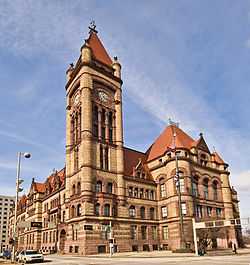Cincinnati City Hall
|
Cincinnati City Hall | |
 | |
|
Cincinnati City Hall | |
| Location | Cincinnati, Ohio |
|---|---|
| Coordinates | 39°06′16″N 84°31′08″W / 39.10441°N 84.51895°WCoordinates: 39°06′16″N 84°31′08″W / 39.10441°N 84.51895°W |
| Architect | Samuel Hannaford [1] |
| Architectural style | Richardsonian Romanesque[1] |
| NRHP Reference # | 72001017[1] |
| Added to NRHP | December 11, 1972[1] |
Cincinnati City Hall is a registered historic building in Cincinnati, Ohio, listed in the National Register on December 11, 1972.
The main building comprises four and a half stories with a nine story clock tower. An optical trick known as forced perspective makes the building appear even larger than it actually is. As it becomes taller, its windows get smaller.[2]
The building was constructed by the David Hummel company of Cincinnati using stone quarried in Wisconsin, Ohio, Missouri and Indiana. Marble stairways and wainscoting originated in Italy and Tennessee, while granite columns were obtained from Vermont. Stained glass windows were installed which depict Cincinnatus and illustrate Cincinnati's early history.[3] A granite statue of Jesus was contributed by the Archdiocese of Cincinnati in 1864 and displayed in the alcove on the south side of the building until 2003.
The first city hall was built on this site in 1852[4] and was demolished in 1888 to make way for the current structure. Construction costs for the building totaled $1,610,000 of which $54,000 was paid to Samuel Hannaford as architect and construction superintendent.[5]
"Cincinnati's City Hall represents the prevailing architectural tastes at the time of its construction and the influence of H. H. Richardson on its designer, Samuel Hannaford. Richardson's winning design for the Cincinnati Chamber of Commerce building was executed in the 1880's; however, the building's demolition in 1911 left City Hall the best remaining example of Richardson Romanesque in Cincinnati. Samuel Hannaford practiced from 1858 until 1897 and made a significant contribution to the architectural heritage of the Cincinnati area."[citation needed]
The building bears a striking resemblance to the city hall buildings in Minneapolis and Toronto.
Notes
- ↑ 1.0 1.1 1.2 1.3 "National Register Information System". National Register of Historic Places. National Park Service. 2007-06-30.
- ↑ Grace, Kevin (2002). "Cincinnati Revealed: A Photographic Heritage of the Queen City". Arcadia Publishing. p. 11. Retrieved 2013-06-05.
- ↑ Grace, Kevin (Jan 4, 2012). "Legendary Locals of Cincinnati". Arcadia Publishing. p. 34. Retrieved 2013-05-07.
- ↑ Jones, Kent et al (Jul 18, 2011). "Historic Downtown Cincinnati". Arcadia Publishing. p. 49. Retrieved 2013-05-04.
- ↑ The Cincinnati City Hall 1802-1896 by Edwin Henderson
| ||||||||||||||||||||
